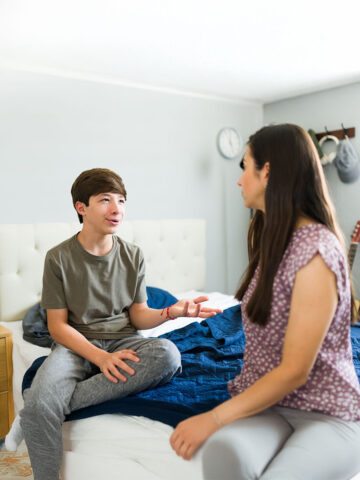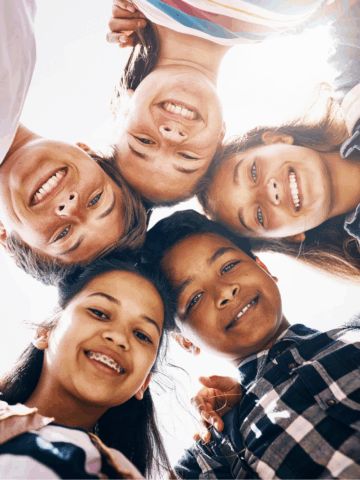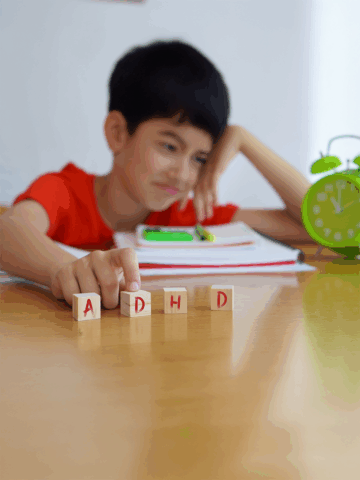For parents, teens and children alike, it’s easy to feel overwhelmed by stress and anxiety in our fast-paced, busy and ever-changing world.
Chances are, everyone has felt the symptoms of stress and anxiety in their bodies and minds at one time or another. Thankfully, there are some tips and tricks to help children and teens respond skillfully to stressful situations. Dr. Katelyn Anderson, a pediatric psychologist at CHOC, offers various skills to help combat anxiety.
1. Belly breathing
When someone feels nervous or stressed, their breathing and heartbeat may increase and their muscles tense and tighten – making it harder to think clearly. But when they can relax their body – through tricks like belly breathing – it can help with anxiety and pain.
How to practice belly breathing with your children
- Start by having them lie down or sit on a chair with their feet flat on the ground.
- Place one hand on their belly and the other on their chest.
- Have your child take a deep breath in through their nose, filling their lungs up with air.
- Their belly expands as they breathe in. The hand on their chest should stay still.
- Have them turn their lips into “O” as they exhale or blow out all the air.
- They should feel their stomach flattens as their muscles tighten.
Belly breathing can be utilized if your child needs to relax or if they are in pain. Like any other skill, the more they practice belly breathing, the better they will become. You can practice belly breathing with the whole family, no matter the age!
2. Getting active
Getting active isn’t just good for physical health; it’s good for mental health!
If your child is feeling bored, tired, hyperactive, sad, angry or nervous, getting out and getting active can help them even out their emotions.
It doesn’t take much time or many supplies to get active – you can let your family’s imagination be your guide for fun activities. If your child has any medical problems, talk to your doctor first about what activities are safe for them. Once you have the go-ahead, the possibilities are endless! You try something new or do an activity you know well.
Activity ideas to help your children and teens get active
For children:
- Taking a family walk outside.
- Riding a tricycle or bike.
- Cleaning and organizing their room.
- Playing pretend outside.
- Playing fetch with your pet.
- Swimming.
- Following a fun, age-specific workout video.
- Dancing to favorite tunes.
- Playing active games with friends and family.
- Jump roping.
- Playing catch or shooting baskets.
Teens may enjoy any of the activities mentioned above, plus:
- Going for a run.
- Weightlifting at the gym – with a gym buddy for spotting!
- Attending a yoga class or doing a yoga video at home.
- Following workout videos online.
- Bike riding.
- Rollerblading.
- Joining a sports team or playing pick-up games with friends.
- Going for a walk or on a hike.
- Joining a dance class.
Let these ideas serve as inspiration to find activities to get active and have fun.
3. Guided Imagery
Have you ever imagined that you’re on a relaxing beach when feeling stressed? It’s actually a true, effective way for someone to cope with stressful times or situations. This strategy is called guided imagery.
How to practice guided imagery
In guided imagery, children and teens can use their imagination to focus on their senses and change the way they think and feel. It’s like daydreaming when your mind wanders; you get to imagine doing something fun.
Read the following steps to your kids as they practice guided imagery:
- Look at videos or photos of a favorite place. Or think of an imagery script, a favorite smell or a favorite memory.
- If you have a photo or video to look at, do that first. Otherwise, go ahead and close your eyes.
- Imagine that you are in your special place. It can be anywhere in the world — you may be at the beach, lying in the grass at the park or in your grandma’s kitchen. Choose a place or memory that makes you feel happy and safe.
- Use all your daydreaming skills and think about every little thing that makes your place special and experience it just as you like it. Think about what you see, smell, taste, hear and feel in your special place.
- If you have a favorite scent or a scent from your memory, you can use that to help you relax into the good place you are visiting in your mind.
- Be aware of how comfortable your body feels when you are imagining yourself in this place. You may notice your breathing slow down and your muscles get looser as your whole body relaxes.
- Once you are relaxed, you can open your eyes.
Sometimes kids may have a hard time doing this imagination activity on their own. If this is the case for your child or teen, you can describe the memorable or special place while they close their eyes and listen.
4. Journaling
A journal is a place for children and teens to write about their thoughts and feelings and record daily activities. It can help them relieve stress, learn more about themselves, process strong emotions and solve problems. Journaling can be helpful when someone is upset, scared or angry, and or when they are excited about something – there’s no wrong way to do it!
To get started, find a notebook and a pen. Pen and paper are best but typing on a tablet or computer can work too. Journaling is best done in a comfortable, relaxing and quiet setting — free from interruptions and distractions.
Have your child start writing, drawing or typing! There is no right or wrong way to journal. If your child doesn’t know what to write about, here are some ideas to get them started. They can write about:
- What they did today.
- Something they’re looking forward to, and why.
- Something they’re worried about, and why.
- A time they felt really strong or proud.
- Something they wish they could change about their life right now.
A journal can be their own private book, or they can share it with others. It’s nice to start with 10 minutes of journaling. Then, the more often they journal, the more they will learn about themselves and the better they will feel!
5. Giving thanks
Giving thanks is not something to wait until Thanksgiving for. Instead, it’s a practice that can be done anytime — in the morning, afternoon or night. It’s a great strategy to help children, teens and adults put things in perspective and make them feel happier.
Although giving thanks can be especially helpful when one is feeling stressed, crabby, frustrated, sad or angry, they can also give thanks when they are feeling fine to remember the great things in their life.
To practice giving thanks, ask your kids to think about the things they are thankful for: maybe it’s their home and belongings, experiences they’ve had or the people in their lives. Then, they can write down the things they are thankful for in a journal or notebook and add stickers, drawings or other scrapbook supplies.
Other than writing a list, here are some other ways to practice giving thanks:
- Write a letter to a loved one. Have your child tell them why they are thankful for them. Then the letter can be mailed or read aloud to them in person or over the phone.
- Every day for a week, have your child write three good things that happened to them that day. Maybe it’s that they made a new friend, got a good grade on a test, felt healthy or had a good conversation with a friend.
- In addition to the three good things that happened, be sure to have them write about what caused the good thing to happen or why it happened. For example, did they meet a new friend because they said hello or tried a new activity? Did they do well on a test because it’s a subject they are good at or because they studied a lot?
- Send someone kind thoughts. Have your child write down all the positive things they wish for someone and give it to them. Try choosing two people to send kind thoughts to — a close family member like a sibling or parent, and a more distant family member or friend
Have fun giving thanks and see how it can help your kids relieve stress!
6. Muscle relaxation
Muscle relaxation perfect way to help calm the bodies and minds of children or teens who are nervous, stressed or upset. By tensing and releasing different muscles, it allows the mind to calm and focus on just that one thing. It can also help both kids and adults practice recognizing when stress or worry may be causing pain and tension in different parts of their body, and how they can release it.
To perform muscle relaxation, have your child start by getting into a comfortable position. They can be lying down or sitting on a chair with their feet on the ground. Then, have them take five to 10 belly breaths. Next, have them start to focus on tensing and relaxing the various parts of the body. Read the following directions for the different parts of the body to your child:
- Face: begin by squeezing all of the muscles in your face — eyes, cheeks, nose and forehead. Scrunch up your face. Hold in tight and count to 10. Then, let go of the tightness and feel the muscles in your face melt into relaxation.
- Jaw: start with your jaw by clenching your teeth, biting down like you have a jawbreaker in your mouth. Hold for 10 seconds and release.
- Shoulders and neck: now move onto your shoulders and neck, squeezing and lifting your shoulders up to your ears — like a turtle. And release. You can repeat this a few times. Make sure to continue your belly breaths through each exercise.
- Back: now arch your back and try to touch your shoulders together, hold and then release.
- Stomach: move down to your stomach, sucking in and making it hard like a rock. Hold it for three seconds and then let it go.
- Arms: to relax your arms, lift them in the air, stretching like you can touch the ceiling and then release. Or squeeze your arms against your body and hold for a few seconds before releasing.
- Hands: for your hands, clench your fists and pretend you’re squeezing something tight in your hands — like you’re squeezing the lemon juice out of lemons.
- Legs, feet and toes: move on to your legs, feet and toes — squeezing and curling your toes underneath your feet and releasing. Imagine a nice feeling of being warm as you relax each of your muscles.
When you finish, take a few deep breaths and enjoy feeling relaxed.
7. Pay it forward
Paying it forward is acting in kind or helpful ways toward another person or animal. Oftentimes, when someone is helpful to others, they may find that they feel happier themselves! Paying it forward should be used in situations when your child feels sad, lonely or angry or when someone else needs cheering up.
To practice paying it forward, all your child needs is some paper, a pen or pencil, and your brain! The first step is thinking of people or animals who could use some help. Then you and your child can come up with ways you could be helpful. Some ideas are:
- Reading a book to a younger sibling, cousin or friend.
- Donating food to a food bank.
- Cleaning up trash in your neighborhood or at the beach.
- Volunteering at an animal shelter.
- Helping family members or neighbors with yard work.
- Offering to babysit for family or friends (as long as your child is old enough!).
- Bringing a snack or treat to someone who is sick.
- Giving a compliment to a friend or classmate.
- Making a card for kids in a hospital or at school.
Soon, your kids will find that helping others will help them feel good too!
View videos explaining each stress relief technique for kids by visiting choc.org/stressrelief
Get more expert health advice delivered to your inbox monthly by subscribing to the KidsHealth newsletter here.
Get mental health resources from CHOC pediatric experts
The mental health team at CHOC curated the following resources on mental health topics common to kids and teens, such as depression, anxiety, suicide prevention and more.





